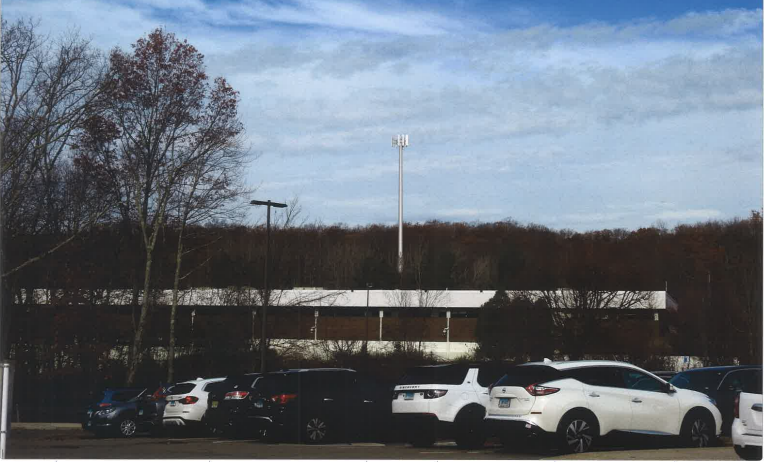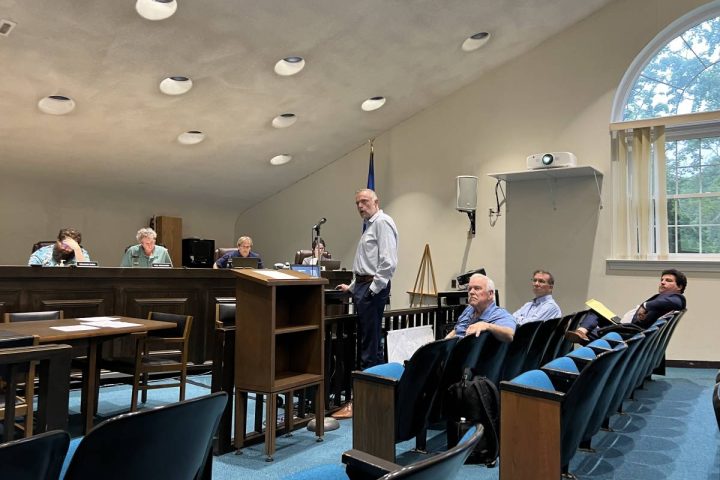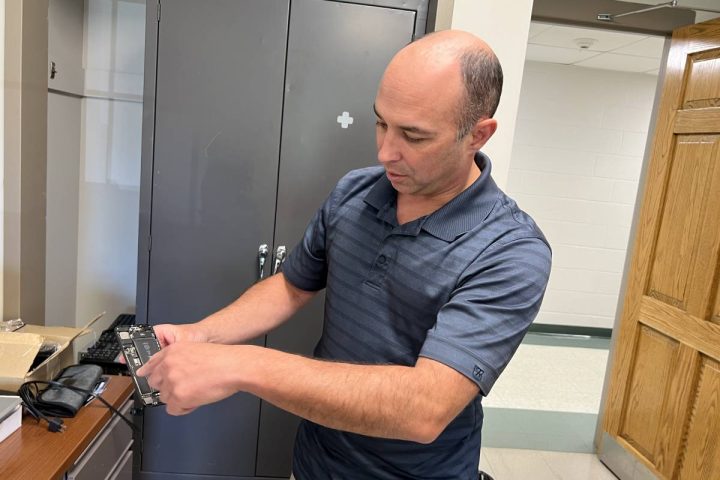MONROE, CT — Residents attending a public information meeting on a proposal for a 170-foot cell tower on town property behind the former Chalk Hill School Wednesday, asked questions about test balloon locations, public health, and suggested alternative sites. But Rachel Cook-Northway of Fan Hill Road posed a question others were likely thinking.
“If we want to stop this from happening, what are the next steps?” Northway asked, adding she understands the developer would go to a private property if the town denies it. “But do we need this tower?” she asked. “We already have four or five in town.”
ARX Wireless wants to construct the tower in the woods on a 72-acre town-owned property at 345 Fan Hill Road, just north of the Chalk Hill building. It would house antennas and equipment for Monroe’s emergency services with room for cellular carriers.
AT&T, which has had a cell on wheels (a.k.a. a COW) in front of Fawn Hollow Elementary School since December of 2012, has expressed interest in the tower and, if it is approved, an existing tower behind the Monroe Volunteer Fire Department would be removed.
Keith Coppins, one of the founders of ARX Wireless, a North Haven firm, said the new tower would improve poor coverage in that part of town, adding space would also be available for Verizon, T-Mobil and the Dish Network.
The town would receive revenue from leasing its property and benefit from having its emergency services equipment on the tower. First Selectman Ken Kellogg said a tower is needed, because the Connecticut Siting Council, which has jurisdiction over cell towers, has granted the town a couple of extensions for its COW, which eventually has to be removed.
Acting Superintendent of Schools Joseph Kobza and Board of Education Chairwoman Donna Lane expressed security concerns should that happen, according to Kellogg.
“I know that the topic of a cell tower would generate questions and concerns and I wanted to ensure that there was a forum that was a little less formal, where people could simply get information and ask questions — and that is the purpose of today’s meeting,” Kellogg said at Wednesday’s meeting, held virtually on GoToMeeting.
Kellogg and Town Planner Rick Schultz have been working with the developer. The first selectman said he had already discouraged having a tower at a previous location behind Jockey Hollow Firehouse, because it was too close to residential properties and “literally in someone’s backyard.”
“Early on, when I was speaking with Mr. Kellogg, we wanted to locate a facility that was basically as far away from the neighbors as we could possibly get — and still get the coverage objective done as well, so that’s why we chose the site where we did,” Coppins said.
Coppins said they received a Federal Aviation Administration certification that a tower at 345 Fan Hill Road would not have to be lit, because it is not tall enough to be a hazard at its location.
ARX Wireless will need Town Council approval of a lease agreement with the town and a site plan approval from the Planning and Zoning Commission.
The test balloon
On Wednesday night, Coppins gave a presentation on the cell tower. At one point he shared 21 photos with computer renderings based on a test balloon, allowing people to see how visible the tower would be in certain locations in town.
The tower was most visible as seen at the former Chalk Hill School, at Jockey Hollow Middle School at 365 Fan Hill Road and at 364 Fan Hill Road. It could also be seen from 47 Flint Ridge Road, but only the top portion of the tower, according to Coppins’ presentation.
John Collins, of Chalk Hill Road, questioned the accuracy of some of the addresses used in the photos, contending the tower would be visible in at least one of the locations where Coppins said it would not be.
David Archambault, who took the photos, explained that while the coordinates of latitude and longitude are very accurate, the actual address may not be in some cases.
Collins also questioned whether other sites were considered. Coppins said his firm focused only on town-owned properties, while trying to work with local officials.
Collins asked how they went from a COW with a van to needing a tower that is 170-feet-tall. For comparisons, he also wanted to know the heights of towers in other towns in the area.
Coppins said his firm did two in Trumbull, a 130-foot tower at the police station and a 160 foot tower at Jeffrey Place, and recently completed a 180 foot tower in Naugatuck. He said the height depends on coverage needs.
Nicole Bierut, of Jockey Hollow Road, noted the Monroe site is over 70 acres and wondered why the developer chose a spot that is so close to a school, a hiking trail and soccer fields when the other side of the property is near the transfer station and a shooting range.
Coppins said they wanted to keep the tower as far away from residences and the trails as possible, but had to be a certain distance from the wetlands buffer.
When having discussions with ARX, Kellogg said finding the least impactful location, while achieving needed coverage in the area was his overarching concern.
Bierut suggested 116 Garder Road as an alternative location, because it is a big, vacant 12-acre property. Coppins agreed to see if that site would work for private carriers and the town’s emergency services, as well as other locations to ensure a complete evaluation is done.
Health concerns
Michelle Parry, of Fairlea Drive, expressed concerns over the safety and environmental impacts of having a tower close to children and wild animals. She asked if the town could ensure radiation emission levels are capped at a safe number.
Coppins said an environmental study is now being done. He also said he would be happy to hire a company that performs power density calculations, which can be kept on file at Monroe Town Hall for public viewing.
The only time power density changes for a tower is when a new carrier is added, according to Coppins. In those cases, he said he would revise the power density number on file.
“It will absolutely comply with all the FCC standards that we are required to do,” he promised.
Northway said she understands how the schools want service, but added she is uncomfortable with a tower being so close to children.
“I have one kid and one on the way and the plan is for them to go to Fawn Hollow,” Northway said of the nearby elementary school. “How can we stop this? I’m losing sleep at night over it. It’s serious.”
She asked Kobza if families who are uncomfortable, would have the option of moving their children out of Fawn Hollow and enrolling them in Monroe Elementary School instead.
Kobza said the district actually put out feelers to see if anybody wanted to do that last year, because Monroe Elementary School had more room in some grades. But he said requests would be handled on a case-by-case basis.
Can the tower be stopped?
As for stopping the tower proposal, Attorney Vincent Marino, the town’s special counsel on land use matters, who represents nine communities, said in his experience, generally, towns and residents are best served when towers are placed on public land, where they have more management and control over the location.
Marino said the town has to weigh the pros and the cons. If it denies the cell tower, it wouldn’t be at 345 Fan Hill Road. But if ARX chooses a private site and files an application before the Connecticut Siting Council, Marino said Monroe loses a voting right.
“If AT&T has stated a specific need to locate a tower in this area, it will begin a search for an alternate site to accommodate its needs,” Marino said. “At this moment in time, the town has the opportunity to control the location of the subject tower and to receive a benefit as a result of that cooperative work with the developer.”
If the developer instead files an application to the Connecticut Siting Council for a tower on private property, Marino said the Council is statutorily obligated to approve it, once it finds there is a need.
“And that hurdle is not terribly difficult,” he said. “By statute, as long as the emissions are within the FCC guidelines, there is no basis for objection based upon health concerns.”
Marino said the town would be “particularly challenged” to object to an alternative location on private property.
Though there would not be at tower at 345 Fan Hill Road with a denial, Marino said, the town would miss out on “hundreds of thousands of dollars in emergency radio equipment,” the ability to control its location to minimize impacts on residential neighborhoods, and to generate non-tax revenue from leasing its property.
Marino said residents who still have concerns or oppose the tower outright, could make their voices heard when the Town Council meets over the lease and when the Planning and Zoning Commission has a hearing on the site plan.






